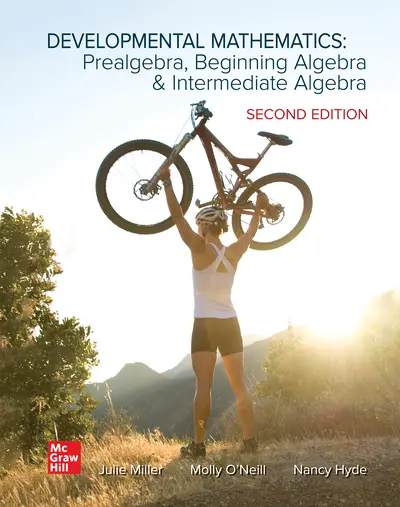My Account Details

ISBN10: 1260728250 | ISBN13: 9781260728255

* The estimated amount of time this product will be on the market is based on a number of factors, including faculty input to instructional design and the prior revision cycle and updates to academic research-which typically results in a revision cycle ranging from every two to four years for this product. Pricing subject to change at any time.
Instructor Information
Quick Actions (Only for Validated Instructor Accounts):
The 2nd Edition of Developmental Mathematics: Prealgebra, Beginning Algebra, & Intermediate Algebra continues the Miller/O'Neill/Hyde author team’s approach in addressing the needs of developmental level students to help them get better results. Updates to the new edition include end-of-section activities, prerequisite review exercises, and new study skills videos.
This new edition is available in ALEKS 360. In a single platform, ALEKS provides a balance of adaptive practice for skill mastery and homework, tests, and quizzes for application and assessment so that you can create the assignments your students need to have the best outcome in your course. In addition to content updates to the text, we are continuously adding new features to ALEKS 360–including new video assignments, an enhanced gradebook experience, end-of-chapter questions aligned to the text, and more.
Chapter 2: Integers and Algebraic Expressions
Chapter 3: Solving Equations
Chapter 4: Fractions and Mixed Numbers
Chapter 5: Decimals
Chapter 6: Ratio and Proportion
Chapter 7: Percents
Chapter 8: Measurement and Geometry
Chapter 9: Graphs and Statistics
Chapter 10: Linear Equations and Inequalities
Chapter 11: Graphing Linear Equations in Two Variables
Chapter 12: Systems of Linear Equations in Two Variables
Chapter 13: Polynomials and Properties of Exponents
Chapter 14: Factoring Polynomials
Chapter 15: Rational Expressions and Equations
Chapter 16: Relations and Functions
Chapter 17: More Equations and Inequalities
Chapter 18: Radicals and Complex Numbers
Chapter 19: Quadratic Equations and Functions
Chapter 20: Exponential and Logarithmic Functions and Applications
Chapter 21: Conic Sections
Chapter 22: Binomial Expansions, Sequences, and Series
Chapter 23 (Online): Transformations, Piecewise-Defined Functions and Probability
Need support? We're here to help - Get real-world support and resources every step of the way.